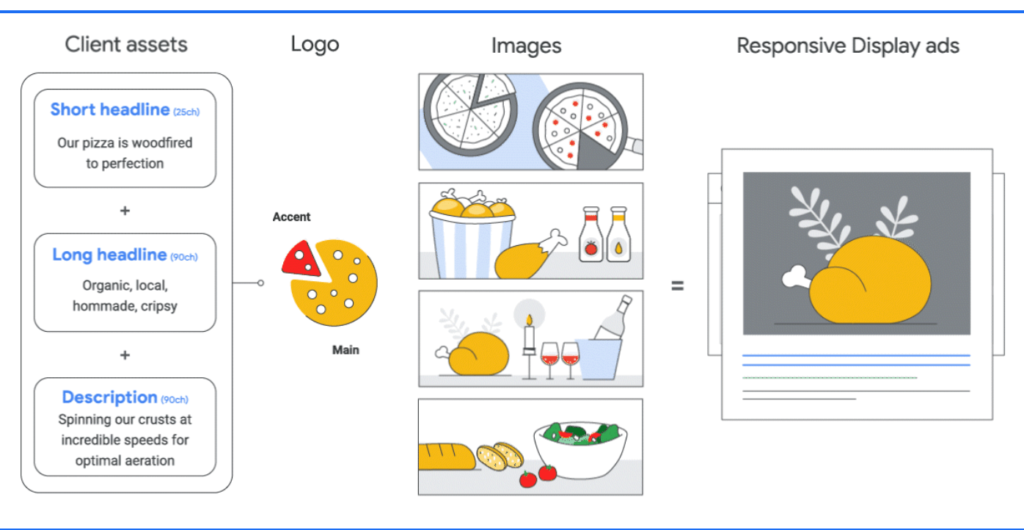Responsive Display Ads: A Comprehensive Guide
Responsive display ads can adjust their size, appearance, and format to fit any ad space within the Google Display Network. With their extensive reach across 3 million inventory partners, including different websites, YouTube, Gmail, and mobile apps, responsive display ads allow advertisers to engage a broader audience and maximize their impact.
In this article, we’ll explain what responsive display ads are, how to create them, and how advertisers use them to reach a wider audience and optimize ad performance!
What are Responsive Display Ads?
Responsive display ads automatically adjust the size, appearance, and format to fit the Google Display Network (GDN) ad space. They also have the most reach out of all display ads.
The Google Display Network helps reach users while browsing websites, watching YouTube videos, checking their Gmail accounts, or using mobile devices and apps. The GDN offers more than 3 million inventory partners.
Responsive ads typically include text elements such as short headlines, long headlines, descriptions, and business names.

They may also include image elements such as marketing images/videos and logo designs. These ads can be used in regular and smart display campaigns, offering flexibility and adaptability in reaching a wider audience.
Overall, responsive display ads offer a cost-efficient way to diversify your ad strategy, making them suitable for small businesses with limited resources and larger brands aiming to improve their ROAS.
How Do Responsive Display Ads Work?
For each ad slot, the machine learning model determines the optimal combination of headlines and uploaded assets (e.g., logos, images, and videos). These assets are the building blocks of ads.
Machine learning uses historical performance data for creative A/B tests to pair the right message to the right user. The optimization process occurs at the time of impression, where Google selects the best combination of assets to create a high-performing ad.
Responsive display ads can appear as almost any size text, image, or native format ad across the Google Display Network, Youtube, and Gmail.
Responsive Display Ads vs. Traditional Display Ads
Traditional display ads contain images provided by advertisers. These ads do not adapt to different ad slots or evolve based on performance. They maintain the same appearance as the images you originally provided.
On the other hand, responsive display ads are the default ad type for the Google Display Network. These ads automatically adjust their size, appearance, and format to fit various available ad spaces. They are designed to adapt their assets to maximize performance.
Responsive ads adjust dynamically to various ad spaces, ensuring optimal visibility and engagement.
| Responsive Display Ads | Standard display ads |
| • Dynamic and adaptable • Optimized for various ad spaces • Adjusts appearance, format, and size • Google’s AI determines optimal combinations • Limited insight into specific ad variations • Ideal for reaching a wide audience | • Static and consistent • Visually impactful • Limited customization options • Full control over design and placement • Detailed performance and analytics available • Traditional and familiar ad format |
How to Create Responsive Display Ads?
When creating a new display ad in Google Ads, advertisers can choose between:
- Responsive display ads;
- Responsive Gmail ads;
- Or upload your own image ads.
Here are the 8 main steps that show how to create responsive display ads in Google Ads:
- Go to your Google ads account.
- Click on Ads and Assets in the right navigation menu, then click the + button.
- Select your display ad type.
- Select the campaign and ad group for your ad.
- Add and save your images.
Additionally, below Images and Logos, there’s an option to click the + button to add a YouTube link to add a video.
- Complete your ad information.
- Preview your ad.
- Click save.
Checkpoints for creating responsive display ads
It’s important to follow Google’s guidelines to avoid ad rejection, such as keeping text within 20% of the image, ensuring content relevance, avoiding misleading or sexual content, using high-quality images, and following trademark policies.
Here are the 6 main checkpoints for creating responsive display ads:
- Headlines. Up to 5 short headlines (up to 30 characters) and 1 long headline (up to 90 characters). Note that the headline may not always appear with the description, so it should be compelling on its own.
- Descriptions. Up to 5 short descriptions, and Google will determine which ones to show based on performance.
It’s worth keeping in mind that these headlines and descriptions can be paired together in any combination. Therefore, advertisers should ensure that all of the assets work together.
- Call-to-action (CTA). CTA should be action-oriented or value-oriented to encourage clicks.
- Business name. Provide the correct and capitalized name of your brand.
- URL. Specify the landing page URL for users who click on your ad, and consider using tracking or custom parameters for better reporting.
- Dynamic ads. If the ad is dynamic, advertisers can add promotion text and a price prefix to boost conversions potentially.
Advertisers should add as many assets as possible, so Google Ads can mix and match them for each available ad space.

Source: Google
Tips for using images in responsive display ads
With responsive display ads, advertisers have the ability to include up to 15 images. Google Ads recommends using at least 5 images as it can lead to higher conversions.
It’s also recommended to use high-definition sizes for images. Popular sizes for display ads include:
- 300×250;

- 970×250;

- 300×50;

- 300×600.

Additionally, there’s an advanced format option where Google generates a video based on the visual and text assets provided.
If no logo is uploaded (up to 5 logos can be added), Google Ads will provide a neutral one, such as an icon or the first letter of a brand name. If that is the case, and you don’t have a logo ready, consider using an AI logo maker to ensure that the logos meet the recommended aspect ratios and have transparent backgrounds.
It’s advised to upload versions of your images with a 1:1 aspect ratio and a 4:1 aspect ratio, both with transparent backgrounds.
Benefits of Responsive Display Ads
Here are 5 benefits why an advertiser should consider using responsive display ads :
- Ad optimization. Responsive display ads allow advertisers to upload different assets (e.g., headlines, logos, videos, and images) into Google Ads. Google’s AI analyzes your performance history and determines the optimal combination of assets for each ad slot.
Advertisers can upload multiple assets (e.g., multiple headlines, descriptions, etc.) Google Ads adjusts your ads’ size, appearance, and format to fit various ad spaces. This flexibility allows your ads to adapt and display as banner ads, dynamic text ads, or other formats based on the available ad space.
- Videos. Advertisers have the option to include videos in their responsive ads. Google Ads will prioritize showing videos instead of images when it predicts that videos will yield better performance, helping to maximize reach and engagement.
- Gain a broader reach. Responsive ads dynamically change to fit every format, giving advertisers’ content a broader reach. As mentioned, the GDN offers more than 3 million inventory partners, and these ads can appear on different websites, Youtube, Gmail, and mobile apps.
- Save time. Using responsive ads simplifies the management of your ad portfolios within ad groups and campaigns. This saves time and reduces the complexity associated with manual ad optimization.
- Dynamic remarketing. Responsive ads support personalized content. Advertisers can add and control a feed with information about products people have viewed on their website or app. This enables the display of ads in both dynamic and static formats, providing a more personalized and relevant ad experience.
The Downside of Responsive Display Ads
While responsive display ads may initially appear as a convenient option for display advertising, it’s important to consider their drawbacks, which can have a negative impact on campaign performance in both the short and the long term.
Customized display ads that provide valuable insights are a more suitable choice for advertisers with objectives beyond awareness. Here 4 are disadvantages of responsive display ads:
Limited control over ads
Responsive display ads rely heavily on Google’s AI to determine the optimal combination of assets. This can result in limited control over the specific appearance and placement of advertiser’s ads, as the AI makes the decisions based on performance history.
As a result, advertisers have less direct influence over their ads’ specific design, format, and placement. The AI algorithm dynamically adjusts the ads’ size, appearance, and format to fit various available ad spaces, making decisions based on its performance analysis.
While this automated approach can save time and effort in managing ad campaigns, it also means that advertisers have less control over the precise presentation of their ads.
Regulatory requirements
Regulatory requirements can pose challenges when using responsive display ads. Advertisers with strict regulatory obligations and must ensure the accurate and consistent display of legal information may find those responsive display ads unsuitable for their needs.
In such cases, alternative ad formats or customization options that provide more control over the ad content and layout may be more appropriate to meet regulatory requirements effectively.
Branding challenges
The dynamic nature of responsive display ads can sometimes make it difficult to maintain consistent branding across different ad placements. The ad formats and appearance variations may not always align perfectly with your brand guidelines.
This lack of control can impact how your brand is presented to the audience. Since the ad format and layout may change dynamically, it may be challenging to maintain a consistent brand identity across different placements and devices.
Advertiser ads’ visual representation and messaging might not align perfectly with brand guidelines or desired creative vision. While responsive ads offer flexibility and adaptability to fit different ad spaces, it’s important to consider the trade-off in creative control.
Less insight into campaign performance
When advertisers use responsive display ads, Google conducts testing to determine the optimal combinations of assets based on their algorithm. However, the information provided to advertisers is limited.
Google only offers four criteria – learning, low, good, and best – to estimate the performance of the ads. Unfortunately, it does not provide detailed insights into which specific ad size, combination, or format was shown at any given time.
As a result, advertisers have to rely on Google’s judgment and trust that the ads being served are indeed the best-performing ones.
This limited data visibility can make it challenging for advertisers to understand the exact factors contributing to the success or failure of their responsive display ads. Without granular insights, making informed optimizations and adjustments to improve campaign performance becomes more difficult.
Performance variability
While AI optimization aims to improve performance, the results may vary. The optimal combination of assets may not always align with the advertiser’s campaign goals or target audience, leading to fluctuations in performance and potentially lower conversion rates.
Advertiser Strategies for Responsive Display Ads
Here are 6 strategies advertisers should consider when using responsive display ads:
- Ad format diversification. The flexibility of responsive display ads enables to experiment with various ad formats. Advertisers test different headlines, descriptions, and visual combinations to find the winning formula that resonates with their audience.
- Image optimization. Advertisers take advantage of the ability to include up to 15 images in responsive display ads. They choose high-quality, eye-catching visuals that capture attention and align with brand identity.
- Compelling headlines. Crafting compelling short and long headlines that entice users to click on ads is essential. Advertisers experiment with different messaging to find the most effective hooks for their target audience.
- Dynamic descriptions. Advertisers create multiple descriptions, allowing Google’s AI to determine the best-performing combination. It’s important to highlight unique selling points, benefits, and CTAs to drive engagement.
- Performance monitoring. Regularly monitoring the performance of responsive display ads and analyzing metrics, such as click-through rates (CTR), conversion rates, and engagement, enables the identification of opportunities for improvement and campaign optimization. For example, you can connect Google Ads to Tableau for more robust data visualization and analysis, further enhancing the ability to identify and act on key insights.
- Compliance. Advertisers must ensure that responsive display ads adhere to legal requirements and policies. Avoiding misleading or irrelevant content, maintaining high-quality images, and following trademark use guidelines is essential.
Conclusion
Responsive display ads offer a versatile and efficient approach to advertising on the Google Display Network.
With their ability to dynamically adjust size, appearance, and format, these ads maximize reach and adapt to various ad spaces, ensuring optimal visibility and engagement. By leveraging Google’s AI and automation, advertisers can save time on creative testing and optimization while focusing on improving overall ad performance.
Responsive ads are suitable for both small businesses with limited resources and larger brands aiming to enhance their ROAS. With their cost-effectiveness, adaptability, and broad reach, responsive display ads are valuable in diversifying ad strategies and reaching a wider audience.
FAQs
How do I choose the right ad network for my responsive display ads?
When choosing the right ad network for your responsive display ads, consider audience reach, ad formats, targeting options, performance tracking, ad quality, cost, and support.
Ensure the network aligns with your target audience, offers suitable ad formats and powerful targeting capabilities, provides comprehensive tracking and reporting, maintains ad quality and brand safety, and offers competitive pricing and reliable support.
What is the most effective responsive display ad format?
The effectiveness of a responsive display ad format can vary depending on the campaign goals and target audience. Nonetheless, the medium rectangle is one of the most common and effective ad formats (300×250).
How can I ensure my ads are compliant with data privacy regulations?
Ensure compliance with data privacy regulations by obtaining user consent, providing transparent privacy policies, and minimizing the collection of personally identifiable information. Regularly audit your practices, collaborate with trusted partners, and honor user preferences to protect privacy and maintain regulatory compliance.
What tools can I use to create and optimize responsive display ads?
You can use Google Ads’ features for responsive ad creation and Canva or Adobe Creative Cloud to create and optimize ad designs. Analytics tools like Google Analytics and A/B testing platforms can also help to improve ad performance.
How do I measure the success of my responsive display ad campaigns?
To measure the success of your responsive display ad campaigns, you can track key performance indicators (KPIs) such as click-through rates (CTR), conversion rates, impressions, and cost per acquisition (CPA). Utilizing tools like Google Ads, Google Analytics, and other ad management platforms can provide detailed campaign performance metrics for evaluation and optimization.


